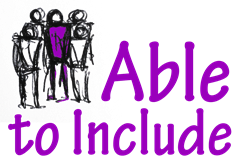The Able to Include final event gave an insight into how digital inclusion can become a reality

“Making digital inclusion possible” was the motto of the Able to Include final event which took place in Brussels. The meeting concluded the Able to Include project, an initiative which developed assistive technology to help people with intellectual disabilities use social media.
Participants from different European countries had come to listen to the presentations which made a link between the general concept of accessibility, experiences made during the development of the Able to Include apps and software layer and the final results.
Ineke Schuurman from Leuven University in Belgium opened the event by giving a short overview of the project: “The aim of Able to Include was to improve the living conditions of people with intellectual or developmental disabilities”, she explained. Several services were developed for this purpose:
– an accessibility layer which is open-source and can be used by developers everywhere
– a text-to-pictogram translator
– a text simplifier
– a text-to-speech programme
– the PictoChat mobility app
– Kolumba, an easy-to-use e-mail web client
Inclusion Europe’s director Milan Šveřepa stressed the importance of the project for independent living: “Access to information is pivotal to taking decisions“, he said – and the Able to Include services help people with intellectual disabilities to obtain the information they need.
Alejandro Moledo, New Technologies & Innovation Officer at the European Disability Forum, emphasized how the lack of accessibility is a problem for all people with disabilities, as “one in three persons with disabilities has never used the internet”. This represents 54% of those who have never been online. All the more important it is to have a strong European Accessibility Act to improve the accessibility of websites all over Europe.
“One in three persons with disabilities has never used the internet”
Alejandro Moledo, New Technologies & Innovation Officer at the European Disability Forum
Liz Tilly and Satnam Singh from Building Bridges Training, one of the project partners, gave an introduction into how they were involved in the development and testing of the different apps. “These apps have given people confidence”, as Liz Tilly put it. The testers are now using the internet more to find information or ask others to do it for them. Some members of the test group even bought their own tablets, and the testing sessions were an opportunity for them to make new friends and connections.
More freedom, more self-determination, more inclusion
John O’Flaherty from MAC, who was involved in the development of the Able to Include services, made the link to the perspective of the developers: “First we developed ‘safe’, cut down versions of selected social media, but users’ feedback clearly indicated that they wish to use the full ‘real’ services.” This is why a “web view” approach was developed to empower people with intellectual disabilities to access the complete Facebook and other social media apps. Safety was provided through optional support, as well as short videos from the Inclusion Europe-led Safe Surfing Project.
Once familiarised with the way a specific tool works, people with an intellectual disability can use it to gain much more freedom and independence. Marta Ripollés from project partner Prodis illustrated this with a video showing one of their clients working with Kolumba. The tool simplifies the interface of a personal email account, specifically of Gmail. “E-mail has become part of our everyday life”, Marta Ripollés said. “Why should people with an intellectual disability be excluded from using it?”

Thomas More University College and the non-profit De Schakel were specifically involved in the development of the PictoChat mobility app which allows people with an intellectual disability to talk with their caregivers by using pictograms. Bart Werrens from De Schakel demonstrated how he used the app to keep in contact, e.g. by sending the picture of a horse when explaining that he was at his workplace, a riding stable. According to Jo Daems from Thomas More, the app has improved many aspects of life for its users, for example their interpersonal relations and sense of social inclusion, but also their self-determination: “The user is able to make contact to others without the help of a caregiver. This is a very important step.”
The event was wrapped up with a presentation on easy-to-read. Juliette Sançois from Inclusion Europe’s member Unapei explained how automation can lead to more easy-to-read texts, while Armony Altinier from Koena, a company specialised in inclusive web development, talked about the importance of user involvement during development: “Programmes need to be dedicated to people, not the other way round”, as she put it.
Participants of the event agreed that Able to Include is a good example of how digital inclusion can be a success. As our information society becomes more and more digitalised, we should make sure to not leave people with intellectual disabilities behind.
The conference presentations are available online.
